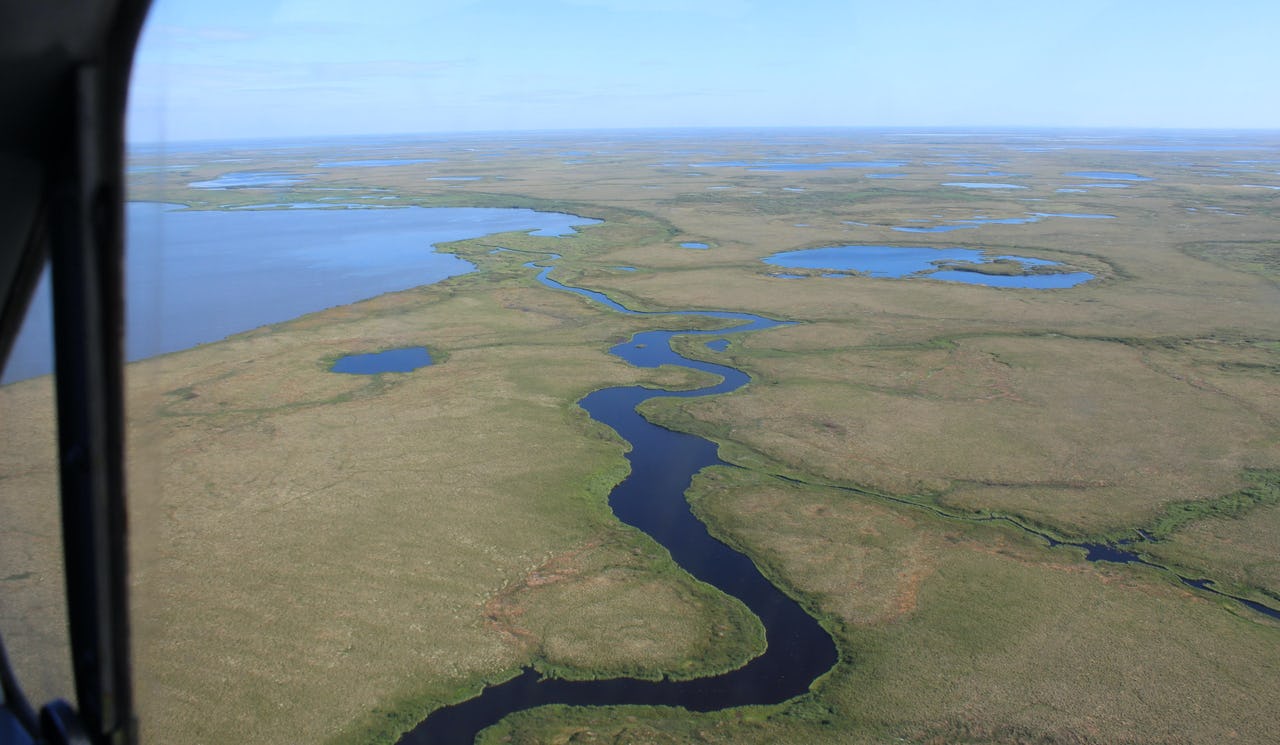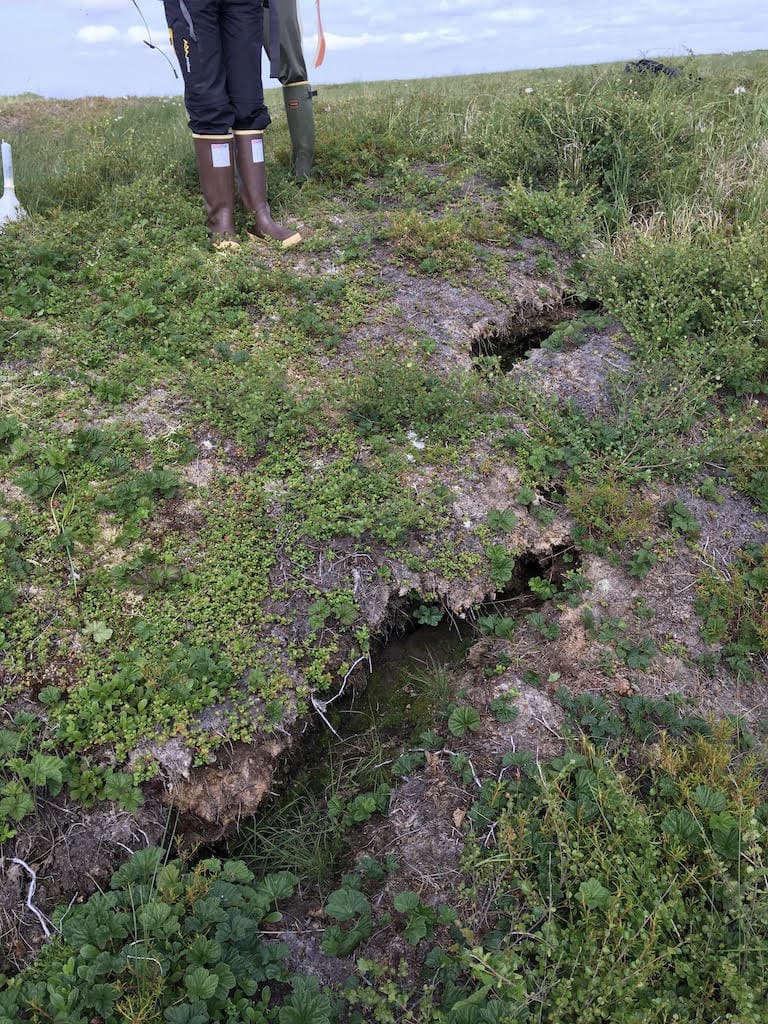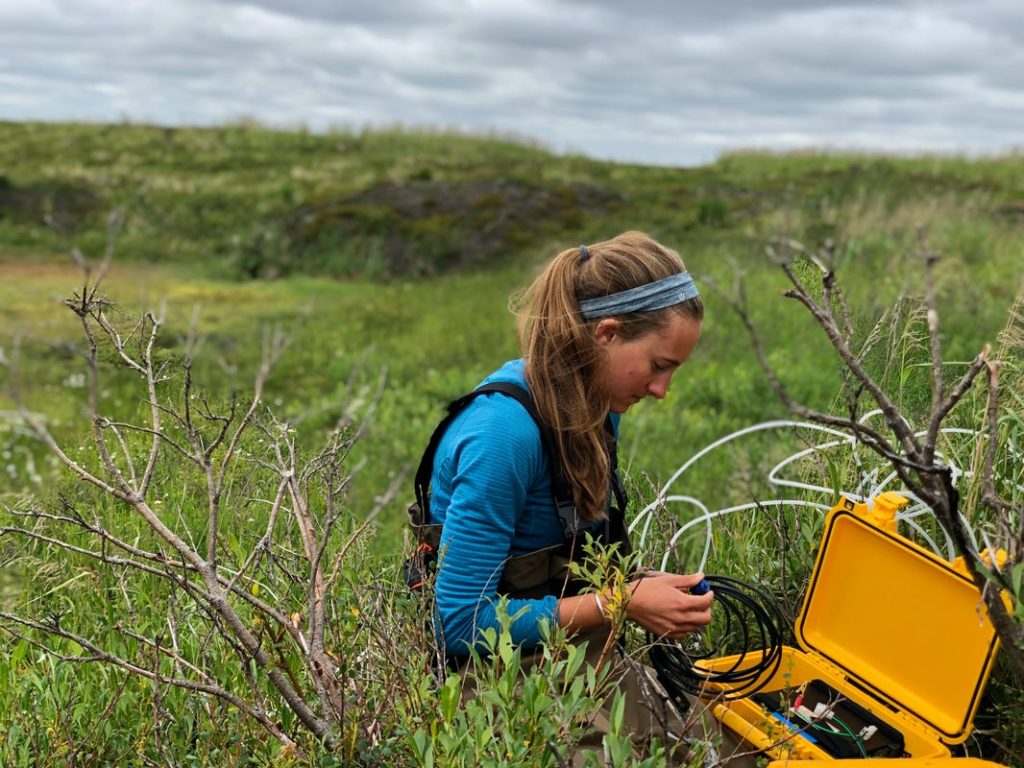Takeaways from the Arctic Tundra

Climate change in the Arctic tundra, like in the Yukon-Kuskokwim Delta, takes the form of thawing permafrost, changes in growing season length, and increased wildfires. Photo: Anneka Williams
Permafrost thaw is one of the world’s most pressing climate problems, already disrupting lifestyles, livelihoods, economies, and ecosystems in the north, and threatening to spill beyond the boundaries of the Arctic as our planet continues to warm. To examine the effects of permafrost degradation, and increase our understanding of what this phenomenon means for the future of the region (and the world), The Arctic Institute’s new two-part permafrost series aims to analyze the topic from scientific, security, legal, and personal perspectives.
The Arctic Institute Permafrost Series 2020
- Permafrost Thaw in a Warming World: The Arctic Institute’s Permafrost Series Fall-Winter 2020
- Takeaways from the Arctic Tundra
- Dwindling Arctic Sea Ice and Impacts to Permafrost Health
- Frozen-Ground Cartoons: A Multiform Innovative Project for Permafrost Science Communication and Outreach
- The Intersection of U.S. Military Infrastructure & Alaskan Permafrost Through the 21st Century
- When ‘Perma’ Is No Longer ‘Perma’: Investigating Permafrost Degradation in Churchill, Manitoba
- A Blessing and a Curse: Melting Permafrost in the Russian Arctic
- Carbon: Three Observations on Life, Death, and Uncertainty in the Permafrost
- Translating Newfound Permafrost Knowledge into Climate Action
In July of 2019 I conducted field work in Alaska’s Yukon-Kuskokwim Delta with the Woodwell Climate Research Center (formerly Woods Hole Research Center) as part of the Polaris Project. I was studying the effects of wildfire on plant-mediated methane flux in Arctic wetlands. There’s no shade amidst the flat expanse of the Arctic tundra, and my colleagues and I were living through an unprecedented heat wave at the height of a particularly intense wildfire season in the region. The experience expanded and challenged my understanding of our world, as we literally felt the vast complexity of climate change under our feet, and saw its effects in our research.
Permafrost is permanently frozen ground and has the capacity to sequester tremendous amounts of carbon. As warming occurs across the globe, permafrost regions experience melt which leads to the release of carbon dioxide and methane. This contributes to a positive feedback loop in which increasing greenhouse gases in the atmosphere contribute to more warming. Permafrost thaw also changes the landscape and topography of different regions. Traversing the tundra landscape, we came across numerous “slumps.” Slumps are mass wasting events caused by rapid permafrost thaw leading to the ground sliding away, often down a slump. My peers and I were shocked to see large chunks of Earth displaced along the sides of thermokarst lakes and took turns peering into the chasms that these upheavals opened up into the soil.
In the field, we had days that reached 90 degrees Fahrenheit, and my fellow scientists and I found ourselves digging deep into the Alaskan soil, cooling our hands in the permafrost-chilled layers below. We scooped out muck to access the frozen layers, sticking our limbs deep into the ground to cool off. The irony of worrying about heat stroke in the Arctic while researching climate change was not lost on us and was a sobering reminder of how pressing the issue of climate change is. And we found ourselves not only studying climate change, but also experiencing it first hand.
It’s hard to articulate the protean nature of the Arctic tundra – the way your ankle rolls in a new direction every step you take as you traverse patches of lichen intermixed with tussocks of grasses. It’s hard to describe the sense of smallness you feel when you look across a flat expanse toward the horizon in every direction. The tundra is beautiful in an other-worldly way. I came to love the fractal patterns of lakes we observed from float planes and helicopters taking us to different field sites, the subtle differences in shades of moss and lichens, the tufty grasses that give an indication of whether there’s a breeze or not, and the constant, soft give of spongy earth underneath the boots of our waders.


Most of the projects on our team’s expeditions were focused at surface level processes, so we were not explicitly working with permafrost, however we almost always carried sharp, metal stakes with us to measure the depth of the “active layer,” which is the layer of soil that freezes and thaws seasonally and is situated on top of the permafrost layer. My advisor has visited the Yukon-Kuskokwim Delta frequently over the past decade and shared with us that each year the active layer thickens as permafrost beneath it melts. This was a sobering fact that indicated just how quickly permafrost is melting. And this permafrost thaw can affect the integrity of a landscape with devastating consequences for communities.
As my colleagues and I researched climate change in the region, we developed a new respect for the incredible amount of change and adaptability occurring in Arctic ecosystems and communities in response to climate change. Across our research team, we examined how wildfire is impacting methane emissions, how wildfires are impacting vegetation composition, how permafrost thaw and resulting ground collapse may impact emissions of gases such as nitrous oxide, and more. Our group became close in a way that only remote, field camp living can facilitate. We supported each other through long days of science, pored over graphs and concept maps each evening, and capped off our days with rousing games of dice and cards. We became a family – bonded by extreme conditions, intellectually-engaging science, and a shared learning experience.
Prior to moving into our field camp on the Alaskan tundra, we had the opportunity to meet with local Yupik people. They explained how climate change is threatening their ability to fish and destabilizing the permafrost upon which they live – a dual threat that may affect the community’s ability to remain in their current location. Hearing these stories was powerful. As visiting scientists, we had the privilege of experiencing the Arctic, including the challenging experiences of an Arctic heat wave and smoke from wildfires. But we only had to adjust to these challenges for the short time period we were there, while Arctic residents are constantly adapting to this rapidly changing environment. Communities that live on the tundra are grappling with permafrost melting underneath buildings and houses. While small changes in topography can be balanced out by stilts, continued permafrost melt continues to destabilize the very land supporting some communities and ultimately could lead to total displacement. Witnessing the fragility of the landscape pushed my fellow scientists and me to consider how our work could be conducted in a way that meshed with local needs and incorporated local knowledge. These conversations were a step in the right direction but moving forward we all agreed we’d like to see more community-based science and more science that honors traditional ecological knowledge.
Six months after returning from the tundra, my peers and I reunited in San Francisco, CA to present our respective research at the American Geophysical Union Conference. Most of us were undergraduates and so the opportunity to share our original research in an international sphere was an exciting and formative opportunity. I was struck by how much I learned from talking to people about my research and how many questions I developed over the course of the conference.
Now more than a year after my time living and working in the Arctic, I continue to reflect on my experience and consider how I draw on it to shape my scientific career moving forward. I am working to both continue to learn from other Arctic stakeholders and researchers as well as share my own takeaways.
Connection to place is vital. I could not have understood the Arctic tundra in its complexity had I not had to survive on it while conducting field work. And even as we make exciting breakthroughs in our ability to gain data from remote sensing, I still believe it’s important to physically engage with a system you study. Likewise, it is important to engage with locals. Traditional knowledge of a place is built over generations of engagement and can’t be matched simply by passing through a place or establishing a temporary field camp. Local knowledge and understanding local needs must become part of the scientific context.
Creating ways to share experiences and learning publicly is meaningful. Storytelling is powerful and often can be lost in technical scientific jargon or dense papers. But science is a story, and telling that story is useful in helping people better understand the world around them and – when it comes to climate change – working to identify innovative solutions. I have found incredible gratification in being able to share the story of my time living and working in Alaska, not just at science conferences but with friends, family, professors, and peers. And I have seen how scientists and non-scientists alike respond to a story in a more visceral way, including taking steps to reduce carbon emissions in their own life after hearing about the consequences of climate change in the Arctic. And this action can extend beyond the individual. Policy engagement is critical. My peers and I left Alaska feeling energized by our work and found ourselves talking about what we could do beyond just writing up our research for scientific publications. And I think it was a valuable exercise to consider what we could learn from our research. Some of us took steps toward reducing our impact in our own lives by more intentionally limiting travel or changing lifestyle features such as diet or purchases to be more sustainable. Others of us began to engage in environmental activism. Science doesn’t happen in a vacuum so situating it in the broader milieu of politics and society is important.
I think it’s safe to say that living and working in the Arctic tundra changed my career trajectory and changed how I view science. Listening to local people describe how they are changing their lives in the face of a changing climate and experiencing the unprecedented heat myself drove home for me the relevance of my work beyond mere publication potential.
Anneka Williams conducted this research in affiliation with the Woodwell Climate Research Center as part of the Polaris Project in 2019. Williams is currently a senior at Bowdoin College in Brunswick, ME.